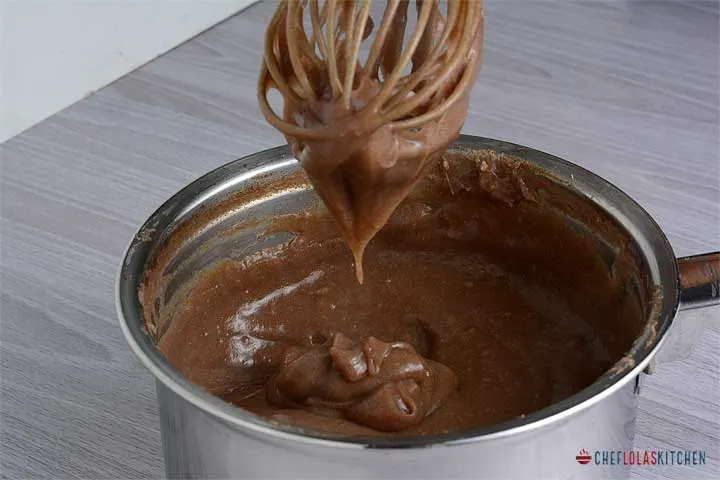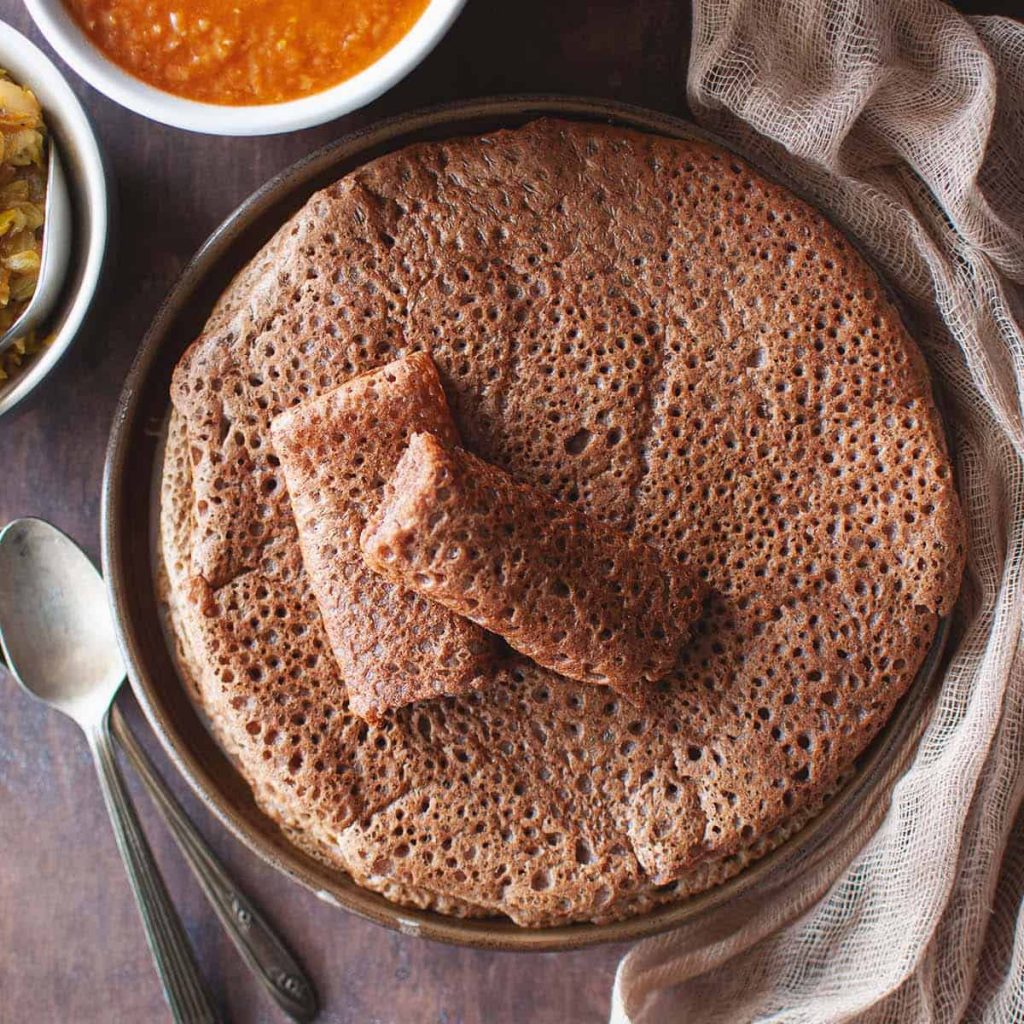
Injera is a delicious, spongy Ethiopian flatbread that’s a staple in many Ethiopian households. It’s not just a bread; it’s a way of life. And the key ingredient that gives injera its unique flavor and texture is teff, a tiny but mighty grain.
Making authentic teff injera might seem a bit intimidating at first, but fear not – we’re here to guide you through it in simple terms. We have also written How To Make Chapati At Home.

Teff flour, mixed with water and allowed to ferment, creates the magical batter that becomes injera. The natural fermentation gives injera its tangy taste and those characteristic bubbles on the surface. (Read also: How to Make Gomen Wat – Ethiopian Collard Greens)
The process is simple, yet requires patience. It’s all about the right balance of ingredients, timing, and technique.
Once you’ve got the hang of it, you’ll be creating your own injera that’s just as good as what you’d find in Ethiopian restaurants.
So, if you’re ready to embark on a flavorful journey to Ethiopia, let’s get started with this authentic teff injera recipe.
What is Teff Injera
Teff injera is a traditional Ethiopian flatbread. It’s made from teff flour and water, left to ferment, resulting in a spongy, slightly tangy bread. Injera is a versatile staple used as both a utensil and a tasty accompaniment to various Ethiopian dishes.
How to make Ethiopian injera step by step?
Ingredients You’ll Need
Before we embark on the journey of making Teff Injera, let’s gather all the essential ingredients. Here’s what you’ll need:
For the Batter
- 2 cups of teff flour (either light or dark teff)
- 1/2 teaspoon of active dry yeast
- 2 cups of warm water
- 1/2 teaspoon of salt (adjust to taste)
For Fermentation
- A large mixing bowl or container with a lid
- A clean kitchen towel or cheesecloth
- A warm, draft-free spot
Special Equipment
- A non-stick skillet or injera pan (12 inches in diameter)
- A lid or aluminum foil (for covering the skillet)
- A whisk or large spoon for stirring
Now that you’ve got your ingredients ready, let’s begin making this delectable Teff Injera.
Ethiopian flat bread

Teff Injera Recipe
1. Preparing the Batter
- Begin by mixing the teff flour and active dry yeast in a large mixing bowl. Add the warm water while stirring continuously until you get a smooth, lump-free batter.
- The batter should be thick, but not so thick that it doesn’t pour easily. If it’s too thick, add a bit more warm water, but don’t make it too runny.
2. Fermentation Magic
- Cover the bowl with a clean kitchen towel or cheesecloth to allow the batter to breathe. Find a warm, draft-free spot in your kitchen, and let the batter ferment for a minimum of 24 hours.
- The longer you let it ferment, the more pronounced the tangy flavor will be. Injera batter benefits from a longer fermentation process, so don’t rush this step.
3. Stirring and Preparing for Cooking
- After the fermentation period, you’ll notice that the batter has a sour aroma, a sign that it’s ready to be used. Stir the batter gently and add the salt. Mix well.

4. The Right Tools
- Now, it’s time to cook your Teff Injera. A non-stick skillet or an injera pan is the ideal tool for this task.
- These pans are typically larger, around 12 inches in diameter, and are specifically designed for making injera. If you don’t have one, you can use a large non-stick skillet.
5. Cooking the Injera
- Heat your skillet over medium-high heat. It’s crucial that the pan is well heated before you start pouring the batter. A hot pan will help you achieve those characteristic bubbles on the surface of the injera.
Recommended: How To Make Mango Juice|Step By Step Guide.
6. Pouring the Batter
- Pour a ladleful of the injera batter onto the hot skillet. Use the back of the ladle to spread the batter outwards in a circular motion, making it as thin as possible without creating holes. Injera should be thicker than a crepe but thinner than a pancake.
7. Cooking and Covering
- Once you’ve poured the batter, cover the skillet with a lid or aluminum foil. This will trap the steam and help cook the injera evenly.
Read also: How To Make Ewa Agoyin
8. Check for Bubbles
- Keep a close eye on the injera as it cooks. It should take about 1-2 minutes for the surface to develop bubbles, and the edges to begin pulling away from the skillet.

9. The Finished Injera
- You’ll know the injera is ready when the surface is dry and there’s no visible moisture. Unlike pancakes or crepes, injera doesn’t need to be flipped.
10. Remove and Repeat
- Carefully remove the cooked injera from the skillet and place it on a clean kitchen towel or a plate. Cover it with a cloth to keep it warm and moist while you cook the remaining batter.
Recommended: A Homemade Jamaican Curry Goat Recipe
Enjoy Your Gluten-Free Teff Injera
- Once all your Teff Injera is cooked, serve it as a base for a variety of Ethiopian stews and dishes. The spongy texture and slightly tangy taste are perfect for scooping up the flavorful sauces and gravies.
Tips for Success
- Teff flour can be found in health food stores, specialty markets, or online. Choose light or dark teff flour according to your preference; they will yield slightly different flavors.
- Patience is key. Let the batter ferment for at least 24 hours for the best flavor.
- When cooking the injera, ensure that your skillet is well heated, and don’t rush the process. The characteristic bubbles and dry surface indicate that it’s ready.
- If you don’t have an injera pan, a large non-stick skillet works well too.
- Teff injera is perfect for scooping up Ethiopian stews, like Doro Wat (spicy chicken stew) or Misir Wat (red lentil stew).
Read also: How To Make Chapati At Home
Frequently Asked Questions (FAQ)
Teff injera vs injera
Teff injera and injera are essentially the same thing. Injera is a traditional Ethiopian flatbread made from teff flour and water.
Teff is the primary ingredient, and the term “teff injera” is often used to emphasize the importance of teff in the bread’s preparation, highlighting its unique flavor and role in Ethiopian cuisine.
Teff doesn’t have to be fermented, but for making traditional Ethiopian injera, fermentation is key. The natural fermentation of teff and water creates the distinctive taste, texture, and bubbles in injera.
Injera is a traditional Ethiopian flatbread made from teff flour, while “teff injera” specifically refers to injera made exclusively from teff, a tiny gluten-free grain, and is the most authentic and common type of injera.
The key ingredient in injera, a traditional Ethiopian flatbread, is teff flour. Teff is a small gluten-free grain that is fermented to create the distinctive sourdough flavor and spongy texture of injera.
Traditional injera is made from teff flour. Teff is a gluten-free grain native to Ethiopia and Eritrea. It is fermented to create the sourdough-like texture and unique flavor of this staple Ethiopian flatbread.

Where can I find Teff Flour?
Teff flour can often be found in specialty grocery stores, health food stores, or online. It’s essential for an authentic Teff Injera recipe.
How do I make the Injera Batter?
To make the batter, mix teff flour with water and allow it to ferment for at least 24 hours. This fermentation process imparts the characteristic tangy flavor.
What’s the key to a Perfect Injera Texture?
The key is achieving a spongy texture. Ensure your batter has the right consistency, and use a hot, lightly oiled pan to create those characteristic holes on the surface.
How long should I cook Injera?
Cook each side of the Injera for a few minutes, until it’s lightly browned and the surface has developed bubbles. Be cautious not to overcook and make it crispy.
Can I substitute Teff Flour?
While traditional Teff Injera uses teff flour, some recipes may incorporate other flours like wheat or barley for various results. However, it won’t be as authentic.
What are common accompaniments for Injera?
Injera is typically served with a variety of stews and dishes, such as Doro Wat (spicy chicken stew) or Misir Wat (red lentil stew). It’s also common to enjoy it with vegetables and salads.
Read More
A Homemade Jamaican Curry Goat Recipe
Conclusion
Making Teff Injera is not only a culinary delight but also a rewarding gluten-free experience. This spongy Ethiopian flatbread, with its tangy and slightly sour flavor, is the perfect accompaniment to a variety of Ethiopian dishes.
The simple ingredients and steps make it accessible to anyone, and the joy of creating this beloved Ethiopian staple at home is unmatched.
So, go ahead, gather your teff flour, let the batter ferment, and start cooking your very own authentic Teff Injera. Your taste buds will thank you for it.
